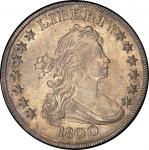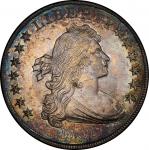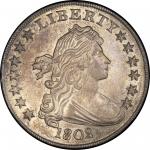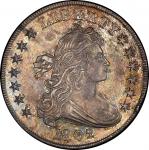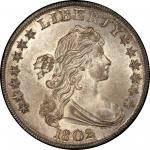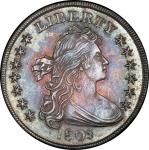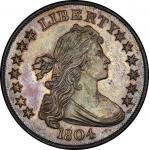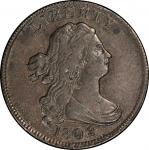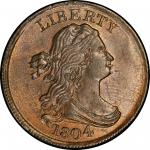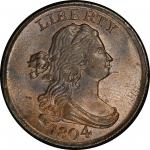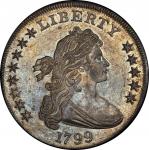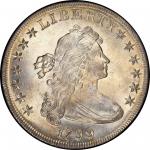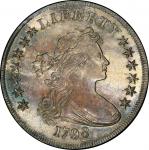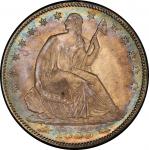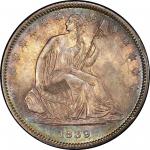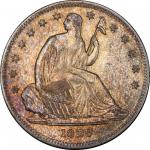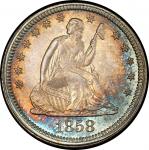I preferred sending a Columbia Bank note for a dollar, to one of Silver (in a letter), as it can readily be exchanged for the latter, and the other Banks issue no notes under five dollars. - George Washington to James McHenry, June 30, 1799With exceptional frost on both sides, this specimen is as highly lustrous as it is crisply defined. Silvery brilliance dominates, but delicate additional shades of pale gold, pastel blue, dusky plum, and hints of green are scattered across both sides. Central and peripheral details are bold, including Libertys expressive portrait, the denticles that frame both sides, the stars around the obverse and those above the eagle, and the feathers of the central obverse. This coin was superlatively well struck despite the relatively late state of the dies, which causes the outer elements of the obverse to draw towards the rim with fatigue. Die rust is seen deep within the recesses of the central obverse portrait, and spalling frames the design elements of the lower reverse, both within the shield and around the talons. A die clash was mostly lapped away, but raised die polish or lapping lines persist in front of Libertys profile and clash marks remain visible at the left side of the reverse star cluster.Both sides show significant cracks. The crack on the obverse is fairly subtle, traversing Libertys drapery and ascending through stars 13, 12, 11, and 10 before intersecting the rim. The reverse displays a major crack across U and through the bases of NITED, crossing the wing and the tops of ST before meeting the rim above the nearby A. Clouds 1 through 3 are joined with a slight crack, as are the bases of ATES. A light hairline crack seems not to intersect any design elements, resting in the space left of OF. A short crack sneaks between IC of AMERICA and another crosses the tail from the arrow feathers to the rim beyond. These cracks place this specimen as Bowers Die State V, the latest described.The obverse shows some marks, mostly on the portrait, and some subtle hairlines in the fields and at center. A tiny well-hidden rim abrasion is located below 79 of the date. A shallow scuff above the eagles head is not instantly discernible. Minor planchet granularity manifests as a vertical streak in the lower left reverse, with some more minor related streaks nearby, and a shallow fissure above Libertys bustline on the obverse, along with a nearly invisible patch along Libertys nose.Paper money made up a vital and substantial proportion of the circulating medium when this coin was struck. United States silver dollars did not see widespread circulation, as no system was in place to distribute the Mints products nationwide. Most depositors at the United States Mint were large Northeastern banks, located in Philadelphia, Baltimore, New York, and elsewhere in the region, and coins were either paid out at their offices, lodged in their vaults, or purchased by entrepreneurs intent on exporting them. This had little impact on the economy, however, as ready supplies of Spanish milled dollars and their fractions, produced throughout Latin America, were available across the United States.Banks from Portland to Savannah emitted notes that saw significant regional circulation, usually in denominations from $5 to $100. These bills were simply printed and prone to counterfeiting, so they inevitably saw greater currency near their issuing authority than distant from it. The Bank of Columbia, a Maryland-incorporated institution, had offices at Georgetown, just up the Potomac River from Mount Vernon. The $1 note that George Washington sent to Baltimore for James McHenry is unknown today, as Eric P. Newmans The Early Paper Money of America lists only a $10 note, though he mentions "other denominations are probable." Today, notes like these are highly collectible and modestly priced despite their extraordinary rarity.There are several Mint State examples of this die variety, led by the Cardinal MS-65 (PCGS), recognizable by the distinctive blue streak across the upper right obverse field. The Davis-Graves coin is untraced since the April 1954 sale, but it was apparently pretty impressive, described as "one of the show pieces of this or any collection; truly a gem and worthy of a home in the finest cabinet. This coin must be seen; the condition Uncirculated does not do it justice." Other Uncirculated survivors are mostly in the lower ranges of Mint State. This example was acquired privately in 1985 and has been off the market since.

